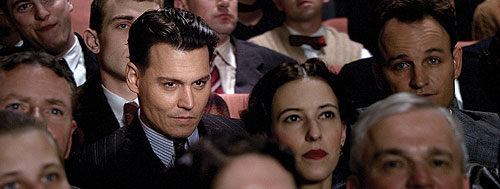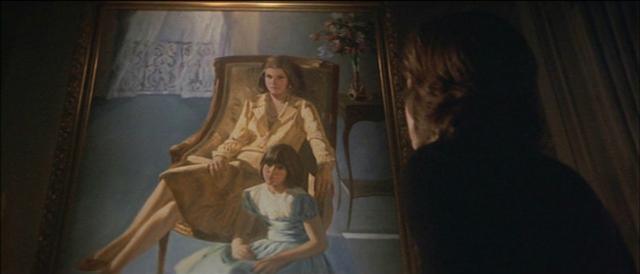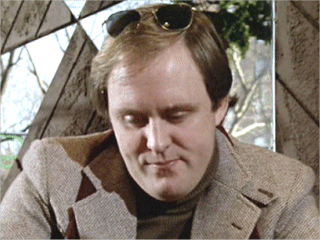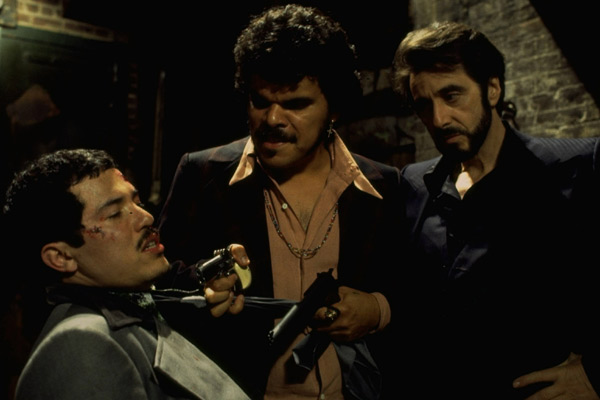PUBLIC ENEMIES ON VIEW
INEVITABLE COMPARISONS TO THE UNTOUCHABLES ENSUE Michael Mann
Michael Mann's
Public Enemies opened today in North America, with many critics referencing
Brian De Palma's
The Untouchables in their reviews of the new film. Here are some samplings:
Marshall Fine at Hollywood & Fine:
As I said, this movie is all about the action: There’s very little that could be construed as scenes of Dillinger planning his heists. The bank jobs themselves are brief – the shoot-outs and get-aways afterward take up more time. There’s little of the flashy melodrama, for example, that made Brian De Palma’s The Untouchables so operatically enjoyable.
James Berardinelli at ReelViews:
Obvious candidates for comparison are Arthur Penn's 1967 touchstone, Bonnie and Clyde, and Brian De Palma's 1987 The Untouchables. Public Enemies lacks the fire and energy of the former and the operatic grandeur of the latter. Mann's approach to this story is businesslike and low-key; he's not trying for something epic. His goal is to demythologize Dillinger - something at which he is only partially successful...
...The director's objective is to emphasize drama over suspense and, as a result, the kind of fast pace and narrative momentum often associated with a thriller is absent here. However, there are individual scenes in which Mann ratchets up the level of tension. The most apparent of these is a seemingly throw-away sequence: after escaping from the Crown Pointe jail, Dillinger and his pals sit at a red traffic light in the stolen car in plain view of everyone in town, including law enforcement officials. It seems that the light will never turn green; endless seconds tick by. Passersby turn to look at the car. The scene, intentionally drawn-out for maximum effect, is as agonizing as De Palma's famous homage to The Battleship Potemkin's Odessa Steps in The Untouchables.
Liam Lacey at The Globe And Mail:
From his first feature, Thief , through his TV series Miami Vice and Crime Story to the epic cops and robbers duel in Heat , Mann has shown himself a poet of shoot 'em up mayhem. Public Enemies should have been his grand opus. Instead, the film feels restrained and pictorial. Compared with the convulsions of Bonnie and Clyde, The Godfather or Brian De Palma's The Untouchables, or the raging gangster flicks of the Thirties, it's a coffee-table book.
Armond White at the New York Press:
Public Enemies tries to out-grandiose De Palma’s lavish The Untouchables but pop-satirist De Palma understood genre. Mann’s just a dilettante. There’s no narrative pulse; this is a show-offy, contemplative crime movie, which means the genre is deadened from the get-go. Long sequences of Dillinger’s heists and breakouts contrast G-Man Melvin Purvis (Christian Bale) in drawn-out pursuit sequences. Even the shoot-outs seem desultory rather than urgent. Not good guys vs. bad guys, but equalizing crime and virtue, chaos and order. Mann’s decision to delete music from the combat scenes (intended to win critical plaudits) creates a dull pretentiousness. Technical flamboyance meets spiritual aridity. Mann’s B-movie cool is never as hip or craftsmanly as Tarantino’s. Mann takes emotion out of gangsterism. His no-hope gunfights avoid a rooting interest; we’re put in a cynic’s position watching history play out— even though Mann’s J. Edgar Hoover–bashing (portrayed by Billy Crudup) rewrites history with smug hindsight. Every scene’s strangely aestheticized, not dramatically involving, as if Mann was stepping back and observing his own masterly canvas.
J.R. Jones at the Chicago Reader:
The liberties Mann takes with the facts are reminiscent of Brian De Palma’s in The Untouchables, where Eliot Ness decides to get tough with Capone by policing outside the lines. Mann has Hoover (Billy Crudup) ordering Purvis to “take off the white gloves.” Subsequently Purvis’s men torture a suspect in his hospital room by applying pressure to a wound and try to beat a confession out of Dillinger’s loyal gun moll, Billie Frechette (Marion Cotillard).
Elliott J. Gorn at Slate:
Ultimately, Mann fails to capture the essence of the Dillinger story because Public Enemies is a gangster movie. The clothes the men wear, the scenes they inhabit, and the language they speak all resonate with that genre. Most of the action takes place in director Michael Mann's hometown, Chicago, and Mann again and again makes references to other gangster films. One can't look at his scenes shot in the lobby of Union Station or at the old financial district on La Salle Street and not think of The Untouchables.
Stephen Schaefer at the Boston Herald:
But what is Public Enemies trying to say really? Unlike Bonnie and Clyde which blatantly and effectively romanticized a pair of Depression era bank robbers as doomed young lovers, Public Enemies presents John Dillinger as too brutal and flawed to be heroic yet hardly a figure of evil. The great Thirties gangster update remains Brian De Palma’s The Untouchables precisely because it was a classic example of the good cop – Kevin Costner’s Eliot Ness – determined to bring down the very bad gangster Al Capone (Robert De Niro). Mann and company have muddied the waters too much – or not enough – making the good guys slightly sinister and creepy and the bad guys not worth cheering, much less crying over.
Kenneth Turan at the Los Angeles Times:
Mann often wants to do traditional films but do them differently, do them better, enabling the audience to feel both the newness and the tradition. With Public Enemies, he has made an impressive film of great formal skill, one that inescapably has a brooding dark-night-of-the-soul quality about it.
Simultaneously an art film and a crime film, Mann's latest work (he shares screenplay credit with Ronan Bennett and Ann Biderman) may not give you a ton to hang on to emotionally, but the beauty and skill of the filmmaking keep you tightly in its grasp...
...The story Mann and company set out to tell is in part the traditional one of the doomed love of outsiders on the run and in part a newer, more socially aware interpretation of gangsterdom, the story of lone criminal wolves, in Mann's words, "being pressed on both sides by twin evolutionary forces -- on the one hand J. Edgar Hoover inventing the FBI, and on the other, organized crime evolving rapidly into a kind of corporate capitalism." We're a long way from The Untouchables here.
AND OTHER REVIEWS OF NOTE...
Sean Burns at the Philadelphia Weekly:
In Mann’s boldest, most controversial stroke, form becomes content in Public Enemies . Dillinger has reemerged into a modern alien landscape he can’t understand, and thus Mann shoots the entire film in handheld hi-definition video. There’s not an establishing shot to be found, or any of the pretty period niceties we expect from pictures like this. The movie looks raw, aggressive and sometimes awfully ugly.
It also looks wrong —1930s icons are in period dress, yet they’re also in overlit, trembling CNN video, surrounded by inconsistent color-timing and strange blurs from the popping light sources. Somehow this insane choice lends a freakish immediacy to Public Enemies, as if it’s happening right now instead of in the distant past. I spent the entire movie on the edge of my seat even though we all already know everything about John Dillinger at the Biograph Theater and the ending is a foregone conclusion.
Matt Zoller Seitz at IFC:
[Mann is] virtually unique among A-list auteurs shooting in high-def in that not only does he not try to make it look like film, he goes out of his way to call attention to the fact that it’s video. Why? A theory: besides indicating a true artist's respect for the properties of the medium he’s chosen (painters don’t break their backs trying to make watercolor resemble oil paint), Mann is looking to amp up immediacy and shatter the usual subliminal reassurances that we’re watching a movie and it’s not “really” happening. Film is about things that happen to other people, usually people who are a lot richer and prettier than we are. Video is about what happens to us, at a birthday party or memorial service, in line at the bank, on the sidelines at a news event. The video-ness of the video in Public Enemies is discombobulating in a good way; when we look at all these handsome men and women in their period clothes, driving their period cars and speaking their period slang, we’re not seeing something that happened long ago, something safely removed from our own experience. It’s happening right now, live, right in front of us. Not many big summer films help us see familiar situations through fresh eyes. Public Enemies is one such movie: perhaps not minor Mann at all, but something major, a work that needs to be seen, absorbed and argued about more than once.
Manohla Dargis at the New York Times:
Michael Mann’s Public Enemies is a grave and beautiful work of art. Shot in high-definition digital by a filmmaker who’s helping change the way movies look, it revisits with meticulous detail and convulsions of violence a short, frantic period in the life and bank-robbing times of John Dillinger, an Indiana farm boy turned Depression outlaw, played by a low-voltage Johnny Depp. Much of what makes the movie pleasurable is the vigor with which it restages our familiar romance with period criminals, a perennial affair. But what also makes it more than the sum of its spectacular shootouts is the ambivalence about this romance that seeps into the filmmaking, steadily darkening the skies and draining the story of easy thrills.
Roger Ebert at the Chicago Sun-Times:
This is a very good film, with Depp and Bale performances of brutal clarity. I'm trying to understand why it is not quite a great film. I think it may be because it deprives me of some stubborn need for closure. His name was John Dillinger, and he robbed banks. But there had to be more to it than that, right? No, apparently not.





 John Lithgow, pictured here from Bob Fosse's All That Jazz, appeared in that film along with Keith Gordon in 1979, right around the time Brian De Palma was working with Gordon on Home Movies and Dressed To Kill. Lithgow had already had his first big role in De Palma's Obsession (1976), and would soon appear in De Palma's Blow Out (1981), and later on, in De Palma's Raising Cain (1992). Lithgow, who is currently filming the fourth season of Showtime's Dexter,
John Lithgow, pictured here from Bob Fosse's All That Jazz, appeared in that film along with Keith Gordon in 1979, right around the time Brian De Palma was working with Gordon on Home Movies and Dressed To Kill. Lithgow had already had his first big role in De Palma's Obsession (1976), and would soon appear in De Palma's Blow Out (1981), and later on, in De Palma's Raising Cain (1992). Lithgow, who is currently filming the fourth season of Showtime's Dexter,  In the shadow of Brian De Palma's Scarface, the director's other collaboration with Al Pacino, Carlito's Way, has its own cult growing. That cult will get a boost this summer when Fabolous releases his new album, Loso's Way, July 28, which features a heavy lineup of guest stars, including Jay-Z, Lil Wayne, and Ne-Yo. Fabolous told
In the shadow of Brian De Palma's Scarface, the director's other collaboration with Al Pacino, Carlito's Way, has its own cult growing. That cult will get a boost this summer when Fabolous releases his new album, Loso's Way, July 28, which features a heavy lineup of guest stars, including Jay-Z, Lil Wayne, and Ne-Yo. Fabolous told  Fabolous says the lead single, "Throw It in the Bag," produced by Tricky Stewart and featuring his labelmate the-Dream, doesn't fit in with the theme, but he explains that "it was so contagious and catchy that we just had to go for it." The motivational "It's My Time," featuring Def Jam newcomer Jeremih and produced by the Runners, which was released in conjunction with "Bag" and appears in a TV ad for the NBA draft, is an example of how Fabolous' and Carlito's stories coincide.
Fabolous says the lead single, "Throw It in the Bag," produced by Tricky Stewart and featuring his labelmate the-Dream, doesn't fit in with the theme, but he explains that "it was so contagious and catchy that we just had to go for it." The motivational "It's My Time," featuring Def Jam newcomer Jeremih and produced by the Runners, which was released in conjunction with "Bag" and appears in a TV ad for the NBA draft, is an example of how Fabolous' and Carlito's stories coincide. 
 Bob Mould, of Hüsker Dü and Sugar fame, was the guest editor at
Bob Mould, of Hüsker Dü and Sugar fame, was the guest editor at 

 Get To Know Your Rabbit, which was mostly directed by Brian De Palma (
Get To Know Your Rabbit, which was mostly directed by Brian De Palma (
 When Warner Bros. opened up its
When Warner Bros. opened up its